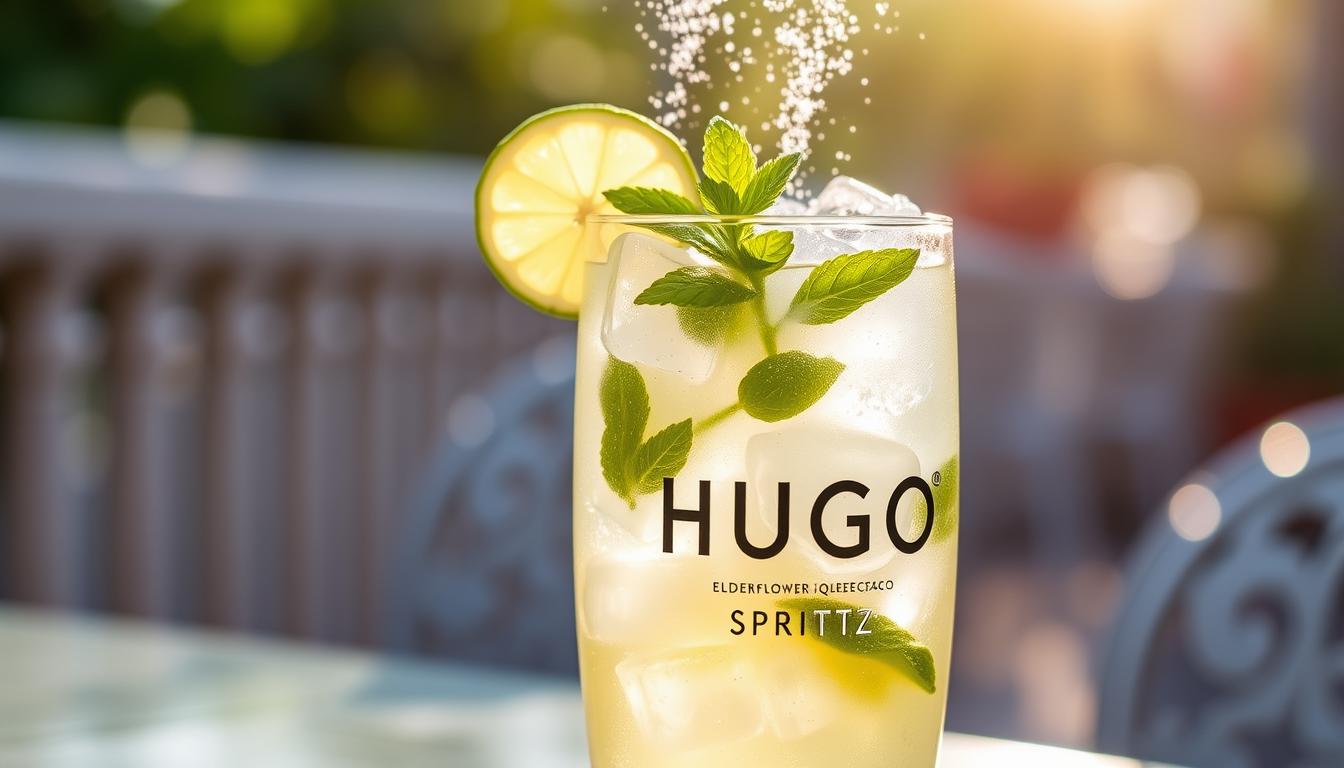Ever wondered about the right amount of St-Germain in a Hugo Spritz? This guide will show you how to make this drink perfect. You’ll learn about its origins, the key ingredients, and expert tips to make it special.
Key Takeaways
- Discover the ideal ratio of St-Germain to other ingredients in the classic Hugo Spritz recipe.
- Learn how to adjust the St-Germain content to suit your personal taste preferences.
- Explore professional bartender tips for achieving the perfect Hugo Spritz every time.
- Understand the unique characteristics that distinguish the Hugo Spritz from the popular Aperol Spritz.
- Uncover the best Prosecco selections to pair with your Hugo Spritz creations.
Understanding the Hugo Spritz Cocktail Origins
The Hugo Spritz comes from the South Tyrolean region in northern Italy. It was first made in Bozen, a beautiful town. The name “Hugo” honors the local culture and dialect.
The South Tyrolean Roots
The Hugo Spritz is a twist on the Aperol Spritz. It uses local ingredients, like elderflower and mint. These add a unique taste that connects to South Tyrolean land.
Evolution of the Modern Hugo
Now, the Hugo Spritz is loved everywhere, not just in South Tyrol. Bartenders have made small changes to the recipe. But, it still stays true to its refreshing and light nature.
Why It’s Called Hugo Spritz
The name “Hugo Spritz” celebrates South Tyrolean culture. “Hugo” is a common name, and “spritz” means bubbly. It’s a drink that shows off the area’s charm.
Essential Ingredients for the Perfect Hugo Spritz
Making a great Hugo Spritz needs the right mix of top-notch ingredients. At its core, it’s about the mix of St-Germain elderflower liqueur‘s floral taste and prosecco‘s bubbly freshness. Let’s dive into what makes this spritz so special.
The base of the Hugo Spritz is the sparkling wine. Choose a prosecco that’s both fruity and dry. This wine is the perfect backdrop for the other flavors to shine.
The St-Germain elderflower liqueur is the main attraction. Its light floral taste and sweetness blend well with the prosecco. This mix makes the cocktail refreshing and balanced. The St-Germain adds a unique charm to the drink.
Adding soda water is a must. It boosts the drink’s fizz, making it crisp and lively.
A sprig of fresh mint is the final touch. It adds a fragrant and cool aroma that brings everything together. The mint’s freshness complements the other flavors, creating a perfect harmony.
By picking and mixing these key hugo spritz ingredients carefully, you can make a Hugo Spritz that excites your senses. It’s a drink that will leave a memorable taste. Let the Hugo Spritz take you to the beautiful places of South Tyrol.
How Much St-Germain Is In Hugo Spritz
The Hugo Spritz is a refreshing cocktail with a delicate balance of ingredients. At its heart is St-Germain, a French elderflower liqueur. It’s key to the drink’s unique flavor.
Standard Measurements and Ratios
The traditional Hugo Spritz recipe has a set ratio of ingredients. It calls for 1.5 ounces of St-Germain, 4 ounces of prosecco, and 1 ounce of soda water. This mix lets the St-Germain’s floral and sweet notes stand out, with the prosecco and soda adding a lively fizz.
Adjusting St-Germain Portions to Taste
Everyone’s taste is different, so you can adjust the St-Germain amount in a Hugo Spritz. Some like more St-Germain, using 2 ounces, while others prefer less, using 1 ounce. It’s all about finding the perfect balance for you.
Professional Bartender Tips
- Use high-quality St-Germain and prosecco for the best results.
- Chill all ingredients thoroughly before assembling the cocktail.
- Stir gently to combine the components, avoiding excessive dilution.
- Garnish with a lemon twist or a sprig of fresh mint to elevate the presentation.
By following these tips and adjusting the St-Germain to your taste, you can make a Hugo Spritz that looks great and tastes amazing. Let your personal taste guide you to mixological perfection.
Comparing Hugo Spritz with Aperol Spritz
The world of spritz cocktails often pits the Hugo Spritz against the Aperol Spritz. These two drinks share some similarities but have key differences. Let’s dive into what makes them unique.
The Aperol Spritz is a classic Italian drink. It’s made with Aperol liqueur, Prosecco, and soda water. Its bright orange color and strong herbal taste make it a favorite in summer. On the other hand, the Hugo Spritz comes from South Tyrolean Italy. It has a lighter, more floral taste.
| Aperol Spritz | Hugo Spritz |
|---|---|
| Aperol liqueur, Prosecco, soda water | St-Germain elderflower liqueur, Prosecco, soda water, mint |
| Bittersweet, herbal flavor | Delicate, floral flavor |
| Vibrant orange color | Pale yellow-green hue |
The Hugo Spritz stands out with St-Germain elderflower liqueur. This adds a light, floral touch. It’s sweeter and more herbaceous, making it a great choice for those who prefer a milder drink.
Both the Aperol Spritz and the Hugo Spritz are enjoyable in their own ways. They cater to different tastes. Exploring their differences can help you find your favorite spritz cocktail.
Step-by-Step Hugo Spritz Mixing Guide
Making the perfect Hugo Spritz at home is easy and can make your cocktail game better. You’ll learn how to pick the right glass and mix it like a pro. This guide will show you how to make a Hugo Spritz that’s just as good as the ones in bars.
Glassware Selection
The Hugo Spritz is best in a wine glass or a large wine glass. These glasses let the drink’s smells and tastes come through. They also look fancy because of their tall shape. Pick a glass that holds 12-16 ounces for the best taste.
Ice and Garnish Techniques
For the right chill and flavor, use big ice cubes or crushed ice. This keeps the drink cold without making it too watered down. A sprig of fresh mint is a classic garnish. It adds a cool touch to your hugo spritz recipe.
Mixing Method
To make the hugo spritz, follow these steps:
- Fill your wine glass with large ice cubes or crushed ice.
- Add 2 to 3 ounces of chilled Prosecco.
- Top with 1 to 1.5 ounces of St-Germain elderflower liqueur.
- Gently stir the ingredients to combine.
- Garnish with a fresh sprig of mint.
Play with the Prosecco and St-Germain amounts to find your favorite mix. The goal is to make a drink that excites your taste buds and is the perfect how to make hugo spritz.
Best Prosecco Selections for Hugo Spritz
Choosing the right prosecco is key to a great Hugo Spritz. This sparkling wine is the base of the cocktail. So, picking the best prosecco is important. Here are some top picks to make your Hugo Spritz even better:
- Mionetto Prosecco DOC: This Italian prosecco is light, crisp, and fruity. It’s perfect for the Hugo Spritz. Its acidity and sweetness balance well with the other ingredients.
- Nua Prosecco DOC Treviso: This prosecco has floral notes and zippy acidity. It adds elegance to the Hugo Spritz. Its clean taste blends well with the cocktail’s flavors.
- Ruffino Prosecco DOC: Ruffino’s prosecco is lively and has peach and apple scents. It’s a great choice for the Hugo Spritz. It works well with the other ingredients.
If you can’t find prosecco, you can use other sparkling wines like cava or Italian spumante. Just pick one that’s dry and crisp. This way, it won’t overwhelm the Hugo Spritz’s flavors.
| Prosecco Brand | Flavor Profile | Ideal for Hugo Spritz |
|---|---|---|
| Mionetto Prosecco DOC | Light, crisp, subtly fruity | Yes |
| Nua Prosecco DOC Treviso | Delicate floral notes, bright acidity | Yes |
| Ruffino Prosecco DOC | Vibrant, effervescent, peach and apple aromas | Yes |
The right prosecco can make your Hugo Spritz amazing. So, pick carefully and enjoy every sip.
Common Hugo Spritz Variations and Twists
The classic Hugo Spritz is loved by many, but there’s more to explore. You can find non-alcoholic options or seasonal twists. Let’s look at some popular hugo spritz variations and creative twists that will excite your taste buds.
Non-Alcoholic Options
If you don’t drink alcohol, you can still enjoy the Hugo Spritz. Here are some non-alcoholic spritz alternatives:
- Virgin Hugo Spritz: Use non-alcoholic sparkling wine or soda water instead of prosecco. Skip the St-Germain for elderflower syrup.
- Cucumber Spritz: Add fresh cucumber slices to the glass. Top with soda water and a squeeze of lime juice.
- Citrus Spritz: Mix orange or grapefruit juice with soda water and a sprig of mint for a lively drink.
Seasonal Adaptations
The Hugo Spritz is perfect for seasonal twists with fresh, local ingredients. Here are a few ideas:
- Springtime Hugo: Muddle elderflowers and top with prosecco, soda water, and a lemon twist.
- Summer Hugo: Infuse St-Germain with fresh berries like raspberries or blackberries. Then, build the spritz as usual.
- Autumn Hugo: Use crisp hard cider instead of prosecco. Garnish with a cinnamon stick and apple slice.
- Winter Hugo: Add cranberry juice to the soda water. Garnish with a sprig of rosemary.
The Hugo Spritz is all about trying new things. Feel free to mix different flavors, spirits, and garnishes. Create your own unique version that shows off your taste and the season.
Serving and Presentation Tips
To make your Hugo Spritz better, focus on how you serve and present it. Chill the drink well, keeping the Prosecco and St-Germain at the right temperature. This makes the flavors refreshing and balanced.
Be creative with your garnishes. Use a mint sprig, a citrus slice, or an edible flower. These add a beautiful touch that matches the drink’s taste.
Pair your Hugo Spritz with light snacks or appetizers. Try fresh fruits, cured meats, or savory bites. This makes the drink stand out and creates a nice dining experience.
Serve the cocktail in a tall, slender glass. A Champagne flute or wine glass works well. It looks elegant and makes you enjoy the drink slowly.
The Hugo Spritz is perfect for any event, from casual summer parties to fancy evening gatherings. Paying attention to serving and presentation makes your drink not just tasty but also beautiful and memorable for everyone.
FAQ
What is Hugo Spritz made of?
Hugo Spritz is a mix of prosecco, St-Germain elderflower liqueur, soda water, and fresh mint leaves.
What is the difference between Aperol Spritz and Hugo Spritz?
Aperol Spritz uses Aperol liqueur, which is bitter and orange-flavored. Hugo Spritz, on the other hand, uses St-Germain elderflower liqueur. This gives Hugo a more delicate and aromatic taste compared to Aperol’s bolder flavor.
Why is it called Hugo Spritz?
It’s named after its origins in South Tyrolean, northern Italy. The area is nicknamed “Hugo,” a common name there.
How much St-Germain is in a Hugo Spritz?
The recipe calls for 1-2 parts St-Germain to 3-4 parts prosecco. You can adjust this to taste, adding more St-Germain for a stronger elderflower flavor.
What is the best prosecco to use for a Hugo Spritz?
Choose a dry, high-quality prosecco for the best Hugo Spritz. Bisol, Mionetto, and Zonin are good options. They should be bright, crisp, and slightly fruity to match the St-Germain’s floral notes.
Can I make a non-alcoholic version of the Hugo Spritz?
Yes, you can make a non-alcoholic version. Replace the prosecco with sparkling water or non-alcoholic sparkling wine. Omit the St-Germain and keep the fresh mint leaves for a mocktail version.

